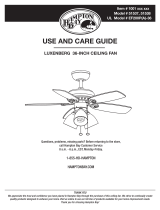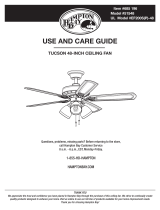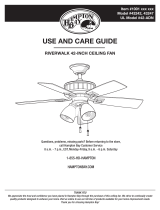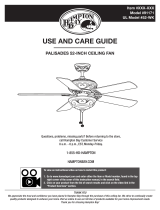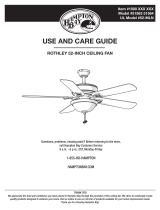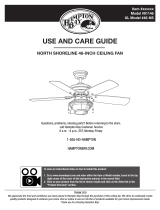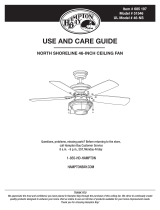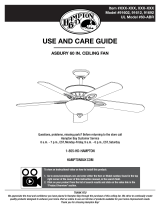
2
Tabla de contenido .............................................................. 2
Información de seguridad...................................................2
Garantía ................................................................................3
Preinstalación ......................................................................3
Instalación ............................................................................6
Ensamblaje ...........................................................................7
Funcionamiento .................................................................14
Mantenimiento y limpieza .................................................15
Solución de problemas .....................................................15
1. Para disminuir el riesgo de descarga eléctrica, asegúrate de
cortar la electricidad del cortacircuitos o la caja de fusibles antes
de comenzar.
2. Todo el cableado debe cumplir con el Código Nacional de
Electricidad ANSI/NFPA 70-1999 y con los códigos locales de
electricidad. La instalación eléctrica debe ser hecha por un
electricista certicado y calicado.
3. La caja eléctrica y la estructura de soporte deben montarse
de forma segura y tener capacidad para sostener de manera
conable 15.9 kg. Usa solamente cajas eléctricas aprobadas por
UL marcadas como “apropiada para sostener ventiladores de
15.9 kg o menos”.
4. El ventilador debe ir montado con un mínimo de 2 m de
separación entre el borde trasero de las aspas y el piso.
5. No muevas el interruptor de reversa mientras las aspas del
ventilador estén en movimiento. Debes apagar y detener las
aspas antes de dar reversa a la dirección de estas.
6. No coloques objetos en la trayectoria de las aspas.
7. Para evitar lesiones físicas o daños al ventilador y otros artículos,
ten cuidado al limpiar el ventilador o al trabajar cerca de él.
8. Los diagramas eléctricos son solo para referencia. Los kits de
luces no empaquetados con el ventilador deben estar aprobados
por UL y marcados como apropiados para ser usados con el
modelo de ventilador que estás instalando. Los interruptores
deberán estar clasicados por UL como de uso general. Consulta
las instrucciones adjuntas a los kits de luces e interruptores para
obtener información sobre el ensamblaje adecuado.
9. Después de concluir las conexiones eléctricas, debes voltear los
conductores empalmados hacia arriba y meterlos con cuidado
en la caja eléctrica. Los cables deben estar separados con el
cable a tierra y el conductor a tierra del equipo hacia uno de los
lados de la caja eléctrica.
10. Todos los tornillos de jación deben ser vericados y ajustados
donde sea necesario antes de la instalación.
ADVERTENCIA: Para reducir el riesgo de lesiones
personales, no dobles los soportes de las aspas
(también llamados “bridas”) durante el ensamblaje ni
después de la instalación. No coloques objetos en la
trayectoria de las aspas.
ADVERTENCIA: Quita los tapones de goma del motor
que están en la parte inferior del ventilador antes de
instalar las aspas o probar el motor.
ADVERTENCIA: Para disminuir el riesgo de incendio o
descarga eléctrica, no utilices este ventilador con ningún
dispositivo de control de velocidad de estado sólido.
ADVERTENCIA: Para evitar una posible descarga
eléctrica, corta la energía eléctrica en la caja principal
de fusibles antes de instalar el cableado. Si crees que
no tienes suciente experiencia o conocimientos sobre
cableado eléctrico, contrata a un electricista certicado.
ADVERTENCIA: Los diagramas eléctricos son solamente
para referencia. Cualquier juego de luces opcional debe
estar aprobado por UL y marcado como adecuado para
ser usado con este ventilador.
ADVERTENCIA: Para reducir el riesgo de incendio,
descarga eléctrica o lesiones personales, instala solo
en una caja eléctrica clasicada como “apropiada
para sostener ventiladores de 15.9 kg o menos” y usa
los tornillos que vienen con esta.
Información de seguridad
Tabla de contenido

































